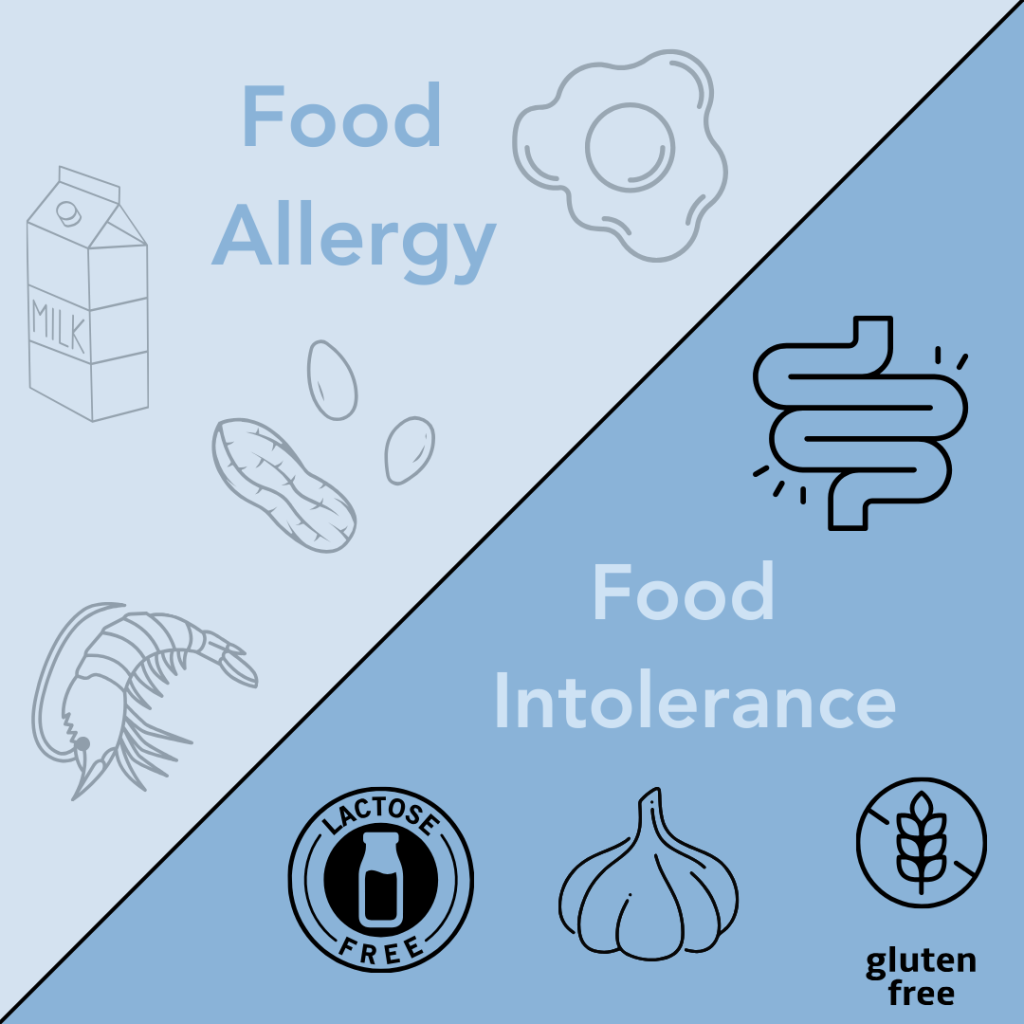Earlier this month we attended the Free from + allergy conference in Sydney. Why did Yakult attend? Did you know that Yakult is gluten free, and with less than 2g of lactose in every bottle of Yakult, most people with a lactose intolerance can tolerate the fermented milk drink.
Knowing what a food allergy is versus a food intolerance can often be confusing. Are there similarities and/or differences between the two? We are here to clear some of the misconceptions.
Let’s start off with food allergies
In Australia, 1 in 10 infants and about 2 in 100 adults experience a food allergy, with such high rates, awareness and correct management is crucial. 1
How does the body react to a food allergy?
The immune system, the body’s line of defence, is involved in food allergies. When a person with a food allergy consumes a food that is usually harmless to most people, the immune system detects a threat from the food, more specifically, the nutrient ‘protein’. To protect itself, the body releases chemicals such as histamine in an act to fight the allergenic reaction.
Following the consumption of the allergenic food, symptoms can range from mild to severe and the onset can be quick, within a matter of minutes up to a couple of hours. This sets off reactions that may have an impact on the cardiovascular system, gastrointestinal tract, skin, or respiratory system. Symptoms can include, itching, hives, swelling, difficulty breathing, digestive issues, low blood pressure and anaphylaxis. 2 Anaphylaxis is the most severe symptom and left untreated it can be life-threatening. 1 Immediate treatment of injected epinephrine with the use of an EpiPen for example, alongside medical treatment is required in emergency cases when experiencing anaphylaxis. 1
You may be wondering what the common allergenic foods are, well, this includes peanuts, tree nuts, shellfish, fish, eggs, milk, wheat, soy, and sesame. 2

There are various tests to diagnose a food allergy including skin prick tests, blood tests (such as specific IgE tests), and oral food challenges conducted under trained personnel (i.e. Accredited Practising Dietitian and/or GP). 3
Four tips for confirmed food allergy management:
- Simply put, the best management is to avoid allergenic foods.
- Food labelling: allergenic foods are required to be bolded on packaged food labels (by February 2024). Often found in the ingredients list, this enables them to stand out and provide consumers with an informed decision.
- Eating out: call ahead and inform staff at the restaurant or café of your allergy and possible options available to you, this will provide clear communication.
- Seek out health professionals including a GP and Dietitian to assist in food allergy management.
So, what is a food intolerance?
Unlike food allergies, which involve the immune system, food intolerances generally affect the digestive system. 4 Food intolerance happens when your body has trouble digesting or dealing with certain foods or their components, for example not having enough of an enzyme (like the lactose enzyme that works to breakdown the lactose sugar in dairy), being sensitive to food additives or other health issues. 1 Symptoms of food intolerances are generally milder than a food allergy, often including gastrointestinal discomfort like bloating, gas, diarrhoea, and abdominal pain. 4 Other non-gastrointestinal symptoms can include hives, headaches and migraines. 1 The onset of symptoms can be delayed, occurring hours to days after consuming the trigger food/s. 4 These symptoms, however mild, are uncomfortable if experienced on a regular basis.
Common types of food intolerances affecting people include lactose (milk and dairy products), fructose (e.g. fruit and honey), non-coeliac gluten sensitivity, food additives like artificial colours, flavours, or preservatives i.e. sulphites and FODMAP’s, also recognised as Fermentable Oligosaccharides, Disaccharides, Monosaccharides, and Polyols. 4
 FODMAP’s are a group of sugars, also known as carbohydrates, that are found in a broad range of foods and additives. 5 In affected people, these sugars are not digested or absorbed properly in the gut when they travel through the gastrointestinal tract. 5 The FODMAP sugar/s draw excess fluid into the small intestine and when they are fermented by the large intestine additional gas is generated. 5 This action of excess fluid and gas production can lead to gastrointestinal symptoms including, irritable bowel syndrome (IBS) symptoms such abdominal bloating and distension, pain, flatulence, and nausea, as well as, diarrhoea (IBS-D), constipation (IBS-C), or both (IBS-M; mixed). 5 For further information, please visit our earlier blog on FODMAP’s here.
FODMAP’s are a group of sugars, also known as carbohydrates, that are found in a broad range of foods and additives. 5 In affected people, these sugars are not digested or absorbed properly in the gut when they travel through the gastrointestinal tract. 5 The FODMAP sugar/s draw excess fluid into the small intestine and when they are fermented by the large intestine additional gas is generated. 5 This action of excess fluid and gas production can lead to gastrointestinal symptoms including, irritable bowel syndrome (IBS) symptoms such abdominal bloating and distension, pain, flatulence, and nausea, as well as, diarrhoea (IBS-D), constipation (IBS-C), or both (IBS-M; mixed). 5 For further information, please visit our earlier blog on FODMAP’s here.
Various tests are available to diagnose food intolerance including, hydrogen breath tests (for lactose and fructose intolerance/s), however this method may not be the most accurate because between clinics they can do things differently. 6 Another way is the elimination and reintroduction method, meaning, that you avoid and/or consume is small amounts the foods you think might be causing problems and see if you feel better when you eat them again. 5 You don’t always need a breath test before doing this. 2, 6 Please note, seek health professional advice prior to commencing, to avoid self-diagnosis and management.
Four tips for food intolerance management:
- If you suspect a food intolerance, seek out health professionals including a GP and a dietitian to provide tailored individualised management.
- Keep a food symptom diary to track food and beverage intake, symptoms, and frequency.
- Low FODMAP diet: this allows the gastrointestinal track to recover and then slowly re-introduce FODMAP containing foods. A low FODMAP diet is a short-term management, ideally you would like to consume a diverse range of foods with minimal restriction were possible.
- Looking after your mental health is also very important. Experiencing these symptoms can be stressful and create fear with completing previous tasks like going out and about, this can exacerbate symptoms. Practice meditation, yoga or a hobby for instance to manage your mental health.

At the conference
The Yakult stall was widely enjoyed by visitors, with over 1,500 bottles given away for free sampling. Attendees visited the stall to learn more about the quality of ingredients, suitability of Yakult regarding specific food allergies or intolerances and the health benefits of exclusive Lacticaseibacillus Paracasei Shirota (LcS) strain.
References
- Allergy and intolerance. NSW Food Authority. https://www.foodauthority.nsw.gov.au/consumer/life-events-and-food/allergy-and-intolerance
- Better Health Channel. Food allergy and intolerance. Vic.gov.au. Published 2012. https://wwbetterhealth.vic.gov.au/health/conditionsandtreatments/food-allergy-and-intolerance
- Diagnosing Food Allergy | NIH: National Institute of Allergy and Infectious Diseases. www.niaid.nih.gov. https://www.niaid.nih.gov/diseases-conditions/diagnosing-food-allergy
- Food intolerance. Healthy Eating Advisory Service. https://heas.health.vic.gov.au/resources/allergies-intolerances/food-intolerance/
- Monash University. About FODMAPs and IBS | Monash FODMAP – Monash Fodmap. Monashfodmap.com. Published 2019. https://www.monashfodmap.com/about-fodmap-and-ibs/
- Usai-Satta P, Oppia F, Lai M, Cabras F. Hydrogen Breath Tests: Are They Really Useful in the Nutritional Management of Digestive Disease? Nutrients. 2021;13(3):974. doi:https://doi.org/
3390/nu13030974
